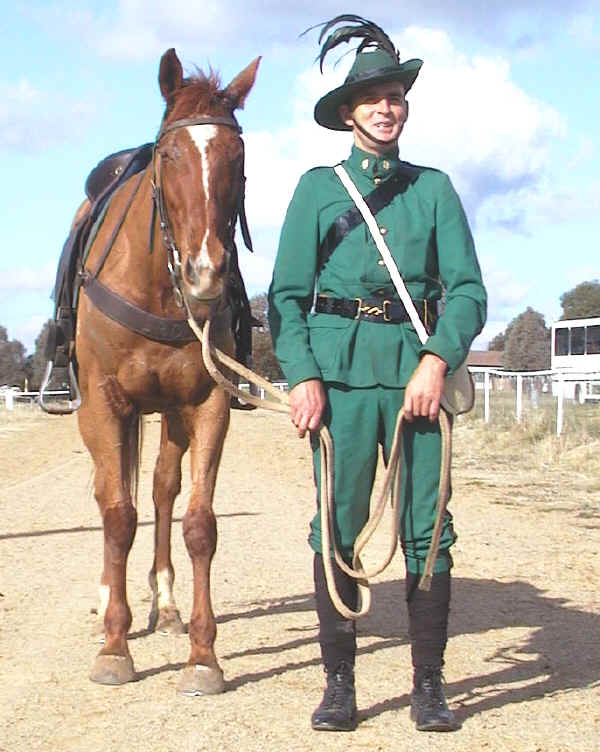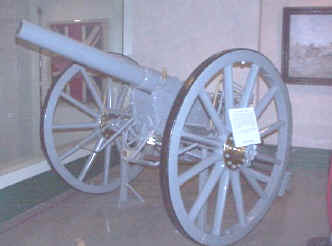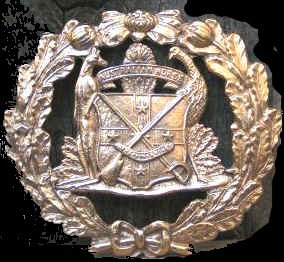 |
|
|||
|
|
||||
 |
FIRST AUSTRALIAN HORSE |
|
Lineage.
<<< Harness badge of the 1st Australian Horse |
||
| The raising of this famous Australian Regiment was due to the
vision and untiring efforts of the enthusiastic Lieutenant Colonel Kenneth
Mackay who, as a Captain, obtained permission from the New South Wales
Government to travel the country districts with a view of enlisting the best
horsemen in the Colony into his Regiment, the 1st Australian Horse.
The first enrolments took place at Murrumburrah on 28 August 1897 and by 20th November, recruiting throughout the country districts was completed with 3,000 eager applicants ready and willing to join the Regiment. Detachments were formed at Murrumburrah, Gunnedah, Gundagai, Quirindi, Mudgee, Scone, Michelago, Boggabri, Cootamundra, Braidwood, Lue, Wallendbeen and Bungendore.
In order to keep the widely scattered detachments at equal strength, only 400 men were selected and a capitation allowance of five pounds was granted by the Government to cover preliminary expenses. Captain Mackay was gazetted Commanding Officer and raised to the rank of Major, and a few months later promoted to the rank of Lieutenant Colonel. He was fortunate to have as his second in command Captain A. F. H. Ferguson, formerly of the 2nd Life Guards, who, with a few N.C.O.s of previous military experience set about training the new recruits in the fundamentals of cavalry drill. They were soon joined by Lieutenant R. R. Thompson, an authorised drill instructor, who contributed much to smartening up the eager recruits. They were eager indeed, for many a part-time Trooper would have to ride forty or so miles to attend a five hour drill, then ride forty or so miles home again, on the same horse.
The first challenge of the Regiment's efficiency arose at the Easter camp of 1898 at Milkman's Hill, when news was received that Major General G. A. French, who had previous service in command of Canada's North West Mounted Police, Commandant of the New South Wales Defence Force, was to inspect the regiment. Fortunately the long awaited uniforms and necessary equipment and swords arrived the day before inspection and the 1st Australian Horse paraded four Squadrons and a mounted band. Although they had never drilled together before, they passed muster well, thanks to the efforts of Captain Ferguson and Lieutenant Thompson, who put the Regiment through their paces just a half hour prior to the inspection. An Imperial British officer spoke of the Junior Regiment of Cavalry as grand fellows, fine riders, and hard as nails - the horses are unsurpassed for the endurance and staying power.
Officers wore dress and undress tunics of myrtle green, the dress tunic being similar to that of the Rifle Regiments, with black mohair braid around the collar, tunic front and the seams at the back, the cuffs featuring black corded Austrian knots, while the front of the tunic was decorated with frogging, terminating in black net caps, and fastening with black olivettes. Breeches were myrtle green with double black stripes along the outside seams.
They fought and rode hard, suffering many casualties in men and horses, during the forty-five engagements of the campaign, which included Pretoria, Belfast, Driefontein, Diamond Hill, Paardeberg, Johannesburg and Kimberly. Their last action was at Heidelburg, before returning home.
A Squadron of the New South Wales Mounted Rifles from Bega was attached to the 3rd Australian Light Horse to bring it up to strength. Colonel Mackay, C.B., remained in command of the Regiment and the Governor, Lord Beauchamp, was appointed Honorary Colonel of both the 3rd and 6th Light Horse Regiments. Permission was obtained to retain the myrtle green uniforms and, like the New South Wales Lancers and the New South Wales Mounted Rifles, they managed to evade the introduction of the new universal khaki uniform for quite a time. On 14 November 1904, the Regiment received the Kings Standard and Colonel Mackay, after giving seven years of tremendous service to the Regiment he created, retired. In May 1908, the honour South Africa 1899-1900 was added for services rendered during the Boer War campaign, and a Pom-pom and Machine Gun Section was formed within the Regiment. When a Trooper defied regulations and polished the black enamel from his brass buttons and badges to smarten up his appearance, his initiative so impressed the Commanding Officer and his Adjutant that an order was issued on 22 December 1908 for all ranks to follow suit. However, their glory was short-lived as, with a reorganisation of the Military forces, the Regiment's title was changed to the 11th Light Horse (Australian Horse) and the wearing of the old myrtle green uniform was discontinued and replaced by the new universal pattern. |
|||||||||||||||
 |
|
A re-created Trooper's Uniform of the First Australian Horse |








